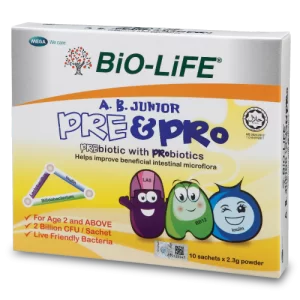
The Guard for The Little Guts
Aug 12, 2017
Introduction
Good health begins in the gut! In fact, our gut is containing various bacteria species – the good and the bad ones. The ideal ratio for good and bad bacteria is 85% to 15%.1 The imbalance of these microflora will result in digestive complaints such as abdominal pain, bloating, constipation, diarrhea, and flatulence. These problems are also common among young children as they are confronting new germs every single day. Antibiotics, as they kill all kind of bacteria, can also cause the imbalance of microflora or dysbiosis.
Dysbiosis can be prevented by nourishing the gut with prebiotic and probiotic. Many of us are already aware of the importance of probiotic, yet, not many of us are familiar with the term prebiotic. In definition, probiotics are live micro-organisms which, when administered in adequate amounts, confer a health benefit to the host.2 Meanwhile, prebiotic is a non-digestible food ingredient that beneficially affects the host by selectively stimulating the growth and/or activity of one or a limited number of bacteria in the colon, thus improve health.3 In simpler words, they are the food for the friendly bacteria in the gut!
So, where do these prebiotic and probiotic originate from? Initially, the acquiring of prebiotic and probiotic begins during and shortly after birth. For example, mode of delivery (normal vs c-section) and infant diet (breast milk vs infant formula) can influence the microbial colonization. Infants who are delivered via normal birth are colonized by vagina and fecal bacteria, including Lactobacillus and Bifidobacterium spp.4 Meanwhile, infants who are delivered via caesarean are colonized by skin bacteria.4
In terms of infant diet, breast milk is the most nutritious food for them to kick-start their early life. Among the nutrients, Human Milk Oligosaccharides (HMOs) play a role as prebiotic by encouraging and establishing the growth and healthy balance of probiotic in the infant’s gut. Therefore, breastfed infants are found to have a higher level of bifidobacterial than formula-fed infants.5 Besides, breastfed infants are exposed to 700 species of milk microbiota6 which is important for their developing immune system.
Nevertheless, infants are not relying on the breast milk for the rest of their life. As they grow up, their food source will be changing from time to time, depending on their age and requirement. When their mothers stop nursing, there will be no more HMOs being supplied in their diet. Moreover, the living probiotic will eventually die especially during antibiotic treatment. To replenish this loss, as responsible parents, you should consider supplementing you kids with prebiotic and probiotic to guard their guts!

BiO-LiFE A. B. Junior Pre & Pro is the first synbiotic formulation that incorporates both prebiotic and probiotic in a sachet. Each sachet contains 1 billion CFU Lactobacillus acidophilus LA-5, 1 billion CFU Bifidobacterium lactis BB-12, and 2.24g chicory inulin as the prebiotic. This triple care formulation carries triple actions for your kids’ health by promoting:
- Better vitamins and minerals absorption, particularly calcium
- Better growth by supporting the growth of good bacteria and enhancing the bone health of the kids
- Better protection by modulating the immune system and reducing the number of sick days
BiO-LiFE A. B. Junior Pre & Pro is suitable for growing kids aged 2 to 12 years old who are under or after antibiotic treatment, having poor digestion and appetite, and suffering from a weak immune system, allergies, lactose intolerance, and gastrointestinal problems. It can also be given to those who did not have the chance to acquire the prebiotics and probiotics from maternal vagina and breastmilk. Uniquely, the powder can be mixed with plain water, milk, or fruit juice, thus making the product to be high compliance in guarding the gut of your little ones.
References
- Utusan Konsumer, May-June 2014. Cover: Your secret immune system. Consumers Association of Penang. ISSN 012-950JX
- FAO/WHO. 2002. Guidelines for the evaluation of probiotics in food: Report of a Joint FAO/WHO Working Group on Drafting Guidelines for the Evaluation of Probiotics in Food. Ontario, Canada.
- Gibson G.R., Roberfroid M.B. 1995. Dietary modulation of the human colonic microbiota: Introducing the concept of prebiotics. Journal of Nutrition, 125(6):1401–1412
- Dominguez-Bello M.G. et al. 2010. Delivery modes shapes the acquisition and structure of the initial microbiota across multiple body habitats in newborns. Proceedings of the National Academy of Sciences of United States of America, 107:11971-11975
- Loo, M. 2009. Integrative Medicine for Children. Retrieved November 10, 2017, from https://books.google.com.my/books?id=bWlu7PgC5IoC&lpg=PR2&pg=PR2#v=onepage&q&f=false
- Cabrera-Rubio R. et al. 2012. The human milk microbiome changes over lactation and is shaped by maternal weight and mode of delivery. The American Journal of Clinical Nutrition, 96:544-551



